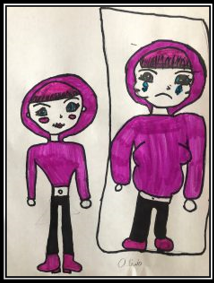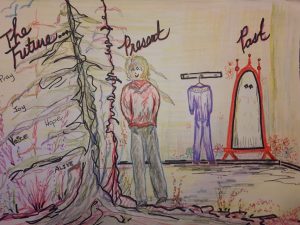6 Start with a Story
Chapter 3
This section discusses our past, present and future hopes and dreams. We want to remind readers that recovery takes time and support from trusted friends, family and health care providers.
Roads to Recovery
Hannah Shares:
“I wish I could say counting calories, restricting food and staring at the scale multiple times a day, are in my past; I still do all of these things. They are embedded in my consciousness, they are part of the me I think I should still be, but also the part of me that is trying to let go. The difference between my former self and the present-day me is perspective. I don’t get lost in the numbers, I don’t obsess with every morsel of food that touches my lips. Instead I breathe and acknowledge the path forward is rarely as straightforward as I would like it to be and tomorrow is always a new day!”

Hannah reflects…
“What is remarkable about the illustration is the dimensions. The person in the mirror wasn’t just wider but also taller. She cast a large shadow on the insecure me who dreaded facing a mirror each day. My first thought was that my daughter sees me the way I see me. When I asked her why the figure in the mirror was so imposing, she implied that the person in the mirror predominated my life. How did she know? How could a small child know that the person I view in the mirror not only caused me shame and dominated my waking hours? It is remarkable to see her insight. That imposing figure looms down over me, every time I look in the mirror.”
Creative Space
- What do you feel and think about when reading Hannah’s reflection and viewing her daughter’s illustration?
- If you prefer to express your responses through art, click on the following: draw, paint.
- Or, create a poem
- If you write in a hard copy journal, upload a picture of your journaling for the day. This is important as it provides perspective through time.
The intention of this exercise is self-reflection; create artwork that illustrates your feelings and/or responses. When you finish, take a picture and upload it to your journal.
How We Understand the Shaping Influences of Experience as We Struggle to Live in Recovery
There are three ideas that frame how we understand our lives as individuals living with eating disorders. The first two ideas relate to experiences and how they influence who we were, who we are, and who we might become. The third idea points us to stories of recovery. These three ideas are highlighted by American educator, John Dewey (1938) when writing about experience, described continuity and interaction:
- Dewey’s, continuity of experience states, “Every experience both takes up something from those which have gone before and modifies in some way the quality of those which come after” (p. 35). From this we understand that “experiences grow out of one another and experiences lead to further experiences … [and] there is always a history, it is always changing, and it is always going somewhere” (Clandinin and Connelly, 2006, p.2). This idea is important because it means changes are possible.
- Dewey’s second criteria of experience, interaction helped us to understand experience is both personal and social. Interaction: “In an experience, things, and events belonging to the world. physical and social, are transformed through the human context they enter, while the live creature is changed and developed” (p. 251). This second bit is important because now we understand not only do experiences change (continuity), we too are capable of change, of being transformed. (include images)
- Reflecting on his ideas about experience Dewey described the importance of “generating a new relationship between a human being and her environment-her life, community and world- one that” (Clandinin & Roseik, 2007, p. 39) “makes possible a new way of dealing with them, and thus eventually creates a new kind of experienced objects, not more real than those which preceded but more significant, and less overwhelming and oppressive (Dewey, 1981b, p. 175 in Clandinin & Rosiek, 2007, . 39). This last bit keeps us hopeful because from it we know there is a way to live our lives that is less overwhelming, oppressive, and disordered.
Hannah shares: “The person I see in the mirror is an accumulation of lived experience. I am a product of the past and the present. The woman you see before you today has lived a traumatic life, one filled with pain related to trauma. I have had to reconcile that these experiences have shaped my identity but that my identity today is fluid. Surely, the future will have an impact on who I am. Thus, the steps I have taken to reconcile my past have already impacted my future self. I am more aware of how my feelings, thoughts, and experiences, shape my behaviour.” – Hannah.
Creation Space
Using your sketchbook, draw or describe three images of yourself, past present, and future. This may include emotions of sadness, grief, as well as rumination about food and fluid intake. Once completed, sit with the images or descriptions; how do you feel when you look at the images or read the descriptions?


Creative Space
Using the ideas of past, present and future, create and describe your life.

